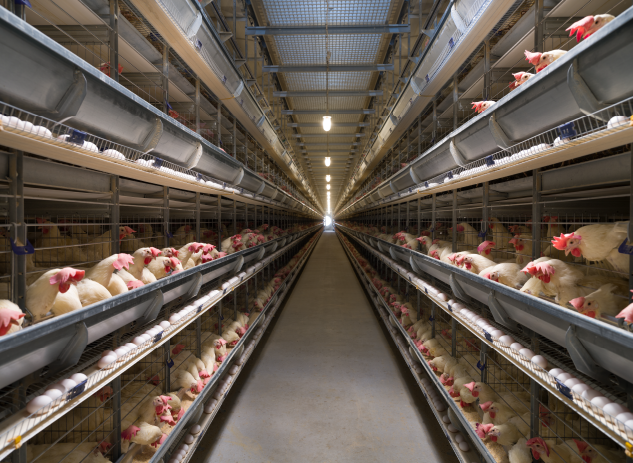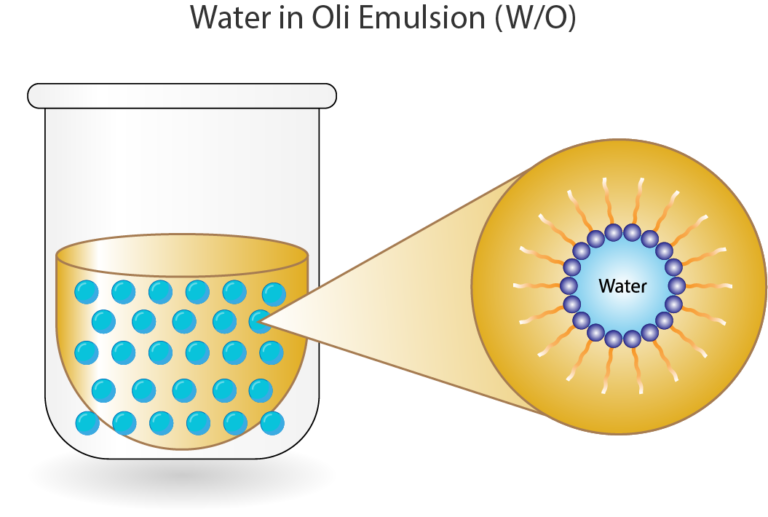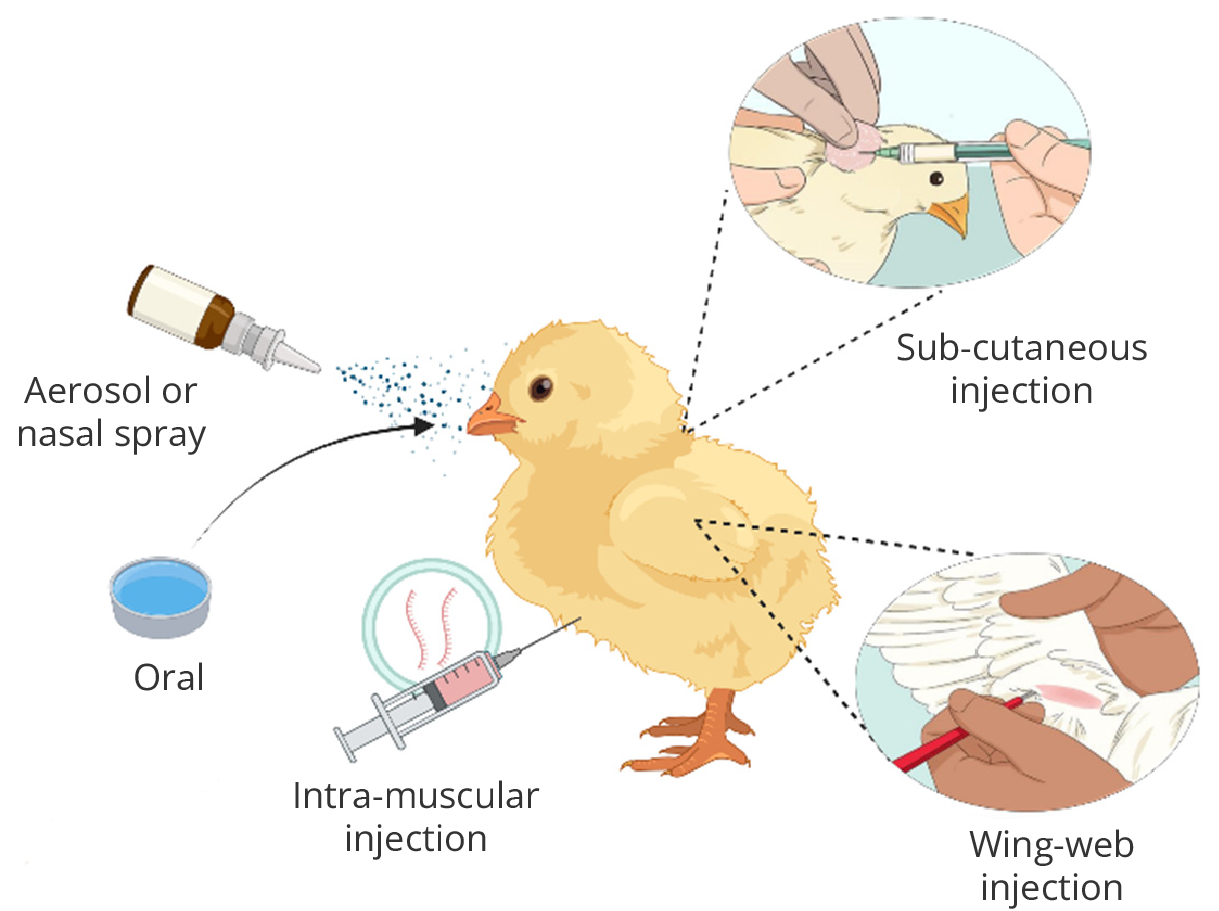The global poultry industry has seen remarkable growth in recent decades, fueled by the increasing demand for affordable protein. However, diseases in poultry can severely affect productivity and the trade of live birds, meat, and other products. Some poultry pathogens are zoonotic, posing risks to human health. The ability to quickly diagnose and identify emerging diseases is crucial. Since avian pathogens disregard national borders and focus only on production sites and their disease control measures, this rapid expansion in poultry production highlights the critical need for effective disease prevention strategies, with vaccination being a key element of modern poultry farming.1,2
In 2020, the global consumption of poultry was so vast that, with over 130 million metric tons of chicken eaten, it’s like the world was consuming the equivalent weight of more than 8,000 Kingdom Towers in Riyadh every single day! Now that’s a truly towering feast!3
The welfare of poultry, particularly concerning disease control, is a critical issue that intertwines with the ongoing genetic modifications aimed at enhancing production. These genetic modifications, though instrumental in achieving higher productivity, often have unintended consequences on the natural immunity and overall health of the birds, raising significant welfare concerns. As production demands intensify, there is an increasing risk that the emphasis on efficiency may overshadow the well-being of the animals leading to compromised disease resistance and increased vulnerability to health issues. This delicate balance between driving production and ensuring animal welfare necessitates a more integrated approach, where the focus on genetic improvements is complemented by strategies that safeguard the health and well-being of the poultry.4

This is where robust health care management practices become indispensable. Effective health care management in poultry requires a holistic approach that encompasses disease prevention and the promotion of overall well-being. This includes meticulous attention to nutrition, ensuring that birds receive the essential nutrients necessary for optimal growth and immune function. Housing must be designed to protect birds from environmental extremes, predators, and stressors, while also providing adequate ventilation and appropriate lighting conditions to support their health. Sanitation and biosecurity are equally critical, involving rigorous cleaning protocols and measures to control the movement of birds, thus preventing the introduction and spread of diseases. Moreover, regular vaccination programs play a pivotal role in protecting poultry from infectious diseases, enhancing both individual bird health and overall flock immunity. Together, these practices are not only vital for maintaining productivity and profitability in poultry farming but also for addressing the growing concerns surrounding animal welfare, ensuring that the pursuit of higher production does not come at the expense of the birds' health and quality of life.5
Chickens who get their vaccinations are basically the superheroes of the barnyard—saving the day one egg at a time by staying healthy and keeping the whole flock safe!

Poultry vaccination plays a pivotal role in the global poultry industry, serving as a cornerstone of disease prevention and health management. With the increasing demand for poultry products and the rise of high-density farming practices, the risk of disease outbreaks has never been higher. Effective vaccination programs not only safeguard animal welfare by preventing the spread of infectious diseases but also contribute to significant economic benefits by reducing mortality rates and production losses. Moreover, vaccinations enhance consumer confidence in the safety and quality of poultry products by mitigating the risk of food-borne pathogens. Recent advances in vaccine technology, including biotechnology-driven innovations, have further amplified the impact of poultry vaccines, making them more effective, stable, and easier to administer. The ongoing development and application of these vaccines are essential for maintaining the sustainability and productivity of the poultry industry in the face of emerging health challenges.6
Poultry vaccines are essential tools in managing the health of flocks, reducing disease incidence, and enhancing productivity. These vaccines can be broadly categorized into three main types: live attenuated vaccines, inactivated vaccines, and recombinant vaccines, each serving specific roles in poultry health management.6

These vaccines contain live pathogens that have been weakened or attenuated so that they cannot cause disease in healthy birds. Live attenuated vaccines are known for their ability to induce strong and long-lasting immunity. However, they carry a risk of reverting to a more virulent form, which could lead to disease outbreaks.6
Inactivated vaccines consist of pathogens that have been killed, typically through chemical or physical processes, such as heat or formaldehyde. They are unable to cause disease but can still stimulate an immune response.6
Recombinant vaccines are a more recent innovation, leveraging biotechnology to produce vaccines that include only the antigens necessary to induce an immune response. These vaccines are created by inserting specific genes from a pathogen into another organism (such as a virus or bacteria) that acts as a vector to deliver the antigen.6
Inactivated vaccines play a crucial role in poultry health management due to their safety and effectiveness. These vaccines are composed of pathogens that have been inactivated, typically through chemical or physical processes. This inactivation ensures that the pathogens cannot cause disease, while still eliciting an immune response in vaccinated birds.6 6
Inactivated vaccines play a crucial role in poultry health management due to their safety and effectiveness. These vaccines are composed of pathogens that have been inactivated, typically through chemical or physical processes. This inactivation ensures that the pathogens cannot cause disease, while still eliciting an immune response in vaccinated birds 6
A key advantage of inactivated vaccines is their safety. Unlike live attenuated vaccines, inactivated vaccines eliminate the risk of the pathogen reverting to a virulent form, making them particularly suitable for use in flocks where minimizing the risk of disease outbreaks is essential.6
Inactivated vaccines are more stable than live vaccines, especially under variable storage conditions. This stability makes it easier to store and transport, which is particularly beneficial in regions where maintaining cold chain logistics can be challenging.6
Often, inactivated vaccines are formulated with adjuvants, which are substances added to enhance the immune response. The use of adjuvants in these vaccines helps to produce a stronger and more durable immunity, thereby reducing the need for frequent booster doses—a significant advantage in large-scale poultry operations where minimizing intervention is crucial.6
These vaccines are applicable across various poultry species and are particularly suitable in situations where live vaccines may pose a risk, such as with immunocompromised birds or in environments where the potential transmission of the vaccine strain to other animals or humans needs to be avoided..6
Adjuvants are critical components in vaccine formulations, designed to enhance the
immunogenicity and stability of antigens. By improving antigen uptake, presentation,
and facilitating a prolonged immune response, adjuvants play a key role in reducing the
required vaccine dosage and production costs. Their use is particularly important in
inactivated and subunit vaccines, where the natural immunogenicity is lower compared
to live vaccines. However, it's crucial that adjuvants used in poultry vaccines, especially
those for broiler chickens, are effective without leaving harmful residues in the meat
consumed by humans. Among the various types of adjuvants, emulsions, particularly
water-in-oil emulsions, stand out for their potency and long-lasting effects.
6
Emulsion adjuvants are formed when two immiscible liquids are combined, with one
liquid creating dispersed droplets within the other, stabilized by a surfactant layer.
These emulsions are more potent than traditional aluminum salts, enhancing both
cellular and humoral immunity, and inducing long-term protection, making them ideal
for animal vaccines. Water-in-oil (W/O) emulsions, where antigen is entrapped in the
water droplets surrounded by a continuous oil phase, this results in the slow release of
antigens upon oil breakdown after injection.6

Flip the cards to Diagnose the flock, let us guess the causing disease
A commercial poultry farm in the Middle East, housing 15,000 broilers, has recently experienced a sudden decline in egg production, accompanied by a rise in respiratory issues among the flock. The birds are showing mild respiratory symptoms, including sneezing, coughing,
and nasal discharge, along with some instances of eye irritation. Notably, a few
birds have developed swollen sinuses, raising concerns about potential exposure to pathogens. Although mortality rates are low, the overall health of the flock appears to be declining, with signs of lethargy and reduced feed intake. The farm's proximity to a wetland area, a known habitat for migratory birds, increases the risk of exposure to prevalent regional viruses.<sup>7</sup>
A poultry farm in North Africa, home to 10,000 layer hens, has recently experienced a surge in respiratory issues among the flock. Birds are exhibiting symptoms such as sneezing, coughing, nasal discharge, and eye lacrimation. Additionally, some birds have started showing unusual neurological signs, including head tilting and twisting of the neck. Mortality rates have risen to 20%, with the affected birds suffering from severe respiratory distress. The combination of respiratory symptoms and neurological abnormalities raises concerns about the presence of a particularly virulent pathogen within the flock.7
In a large poultry operation in the Gulf,
where 12,000 layer hens are kept, a
concerning situation has arisen with a
noticeable drop in both egg production
and quality. The eggs being produced are
often misshapen, with thin, brittle shells.
Alongside these reproductive issues,
many birds are experiencing respiratory
problems, including coughing, sneezing,
and nasal discharge. Some birds have
developed swollen sinuses, while others
show signs of watery eyes. The flock's
overall vitality is declining, with reduced
feed intake and general lethargy. These
symptoms, particularly the egg defects
coupled with respiratory distress,
suggest a viral challenge affecting the
respiratory and reproductive systems.7
Avian Influenza Virus (AIV) is a highly contagious pathogen that poses a significant threat to poultry health worldwide. Classified into two main types based on pathogenicity—Highly Pathogenic Avian Influenza (HPAI) and Low Pathogenic Avian Influenza (LPAI)—AIV can cause varying degrees of illness in birds. HPAI is known for causing severe disease with high mortality rates, while LPAI typically results in milder symptoms, such as respiratory distress and reduced egg production, with lower mortality. The H9N2 subtype, a prominent strain of LPAI, is particularly widespread in regions such as Asia, the Middle East, and Africa. Although H9N2 usually causes mild disease, it can still significantly impact poultry production by reducing flock vitality and productivity. Additionally, LPAI viruses, including H9N2, have the potential to mutate and acquire increased virulence, emphasizing the need for vigilant monitoring and effective disease management strategies to prevent outbreaks and limit their spread.7
Newcastle Disease Virus (NDV) is a highly contagious and virulent pathogen that affects a wide range of avian species, with significant implications for poultry production globally. NDV is classified into three main pathotypes based on the severity of the disease: velogenic (highly virulent), mesogenic (moderately virulent), and lentogenic (low virulence). The velogenic strains are particularly dangerous, causing severe respiratory distress, neurological symptoms such as head tilting and twisting of the neck, and high mortality rates, which can devastate entire flocks. Mesogenic strains typically result in milder disease but can still cause significant economic losses due to reduced egg production and weight gain. Lentogenic strains, often used in live vaccines, generally cause subclinical infections with mild respiratory symptoms. NDV spreads rapidly through both direct contact with infected birds and indirectly via contaminated equipment, feed, or water, making biosecurity measures and vaccination crucial in controlling outbreaks.7
Infectious Bronchitis Virus (IBV) is a highly contagious respiratory pathogen that primarily affects chickens, causing significant economic losses in poultry production worldwide. IBV is an enveloped, positive-sense RNA virus that belongs to the coronavirus family. It primarily targets the respiratory system, leading to symptoms such as coughing, sneezing, nasal discharge, and in some cases, conjunctivitis. However, certain strains of IBV can also affect the reproductive and renal systems, leading to poor egg quality, misshapen eggs, and reduced egg production, as well as kidney damage. The virus spreads rapidly through aerosol transmission, direct contact with infected birds, and contaminated equipment. Due to the virus's high mutation rate, numerous strains exist, making control and prevention challenging. Vaccination is the primary method of controlling IBV, though the variability among strains means that vaccines may not provide complete protection against all circulating types. Thus, ongoing monitoring and vaccine development are essential in managing IBV outbreaks.7
Inclusion Body Hepatitis (IBH) in poultry, caused by Fowl Adenovirus (FAdV), is an acute disease that predominantly affects young broilers, typically under 5 weeks of age. The disease is characterized by a sudden increase in mortality, which can reach up to 30%, and is often accompanied by symptoms such as lethargy, reduced feed intake, and anemia. Affected birds may also exhibit pale, friable, and swollen livers with hemorrhagic lesions. The disease is mainly transmitted vertically, but horizontal transmission can also occur, contributing to the spread of the virus within flocks. Currently, there are no specific antiviral treatments for IBH. Supportive care, such as optimizing nutrition and managing secondary infections, can help reduce mortality. However, the most effective strategy for controlling IBH is the implementation of robust vaccination programs. Vaccination of breeder flocks is crucial to provide maternal antibodies that protect the progeny during the early stages of life, significantly reducing the incidence of IBH in broilers.8
Egg Drop Syndrome-76 (EDS-76) is a viral disease caused by Duck adenovirus A, which primarily affects laying hens, leading to significant economic losses in the poultry industry. The disease is characterized by a sudden drop in egg production, often accompanied by the laying of soft-shelled or shell-less eggs. Affected hens may appear otherwise healthy, but the quality and quantity of egg production are severely compromised. The virus primarily replicates in the oviduct, particularly in the uterus, which leads to the observed symptoms. EDS-76 can cause widespread economic damage due to reduced egg production and poor egg quality. There are no specific antiviral treatments available for EDS-76; therefore, prevention through vaccination is crucial. Vaccination programs for breeder and layer flocks are the most effective method to control the spread of the virus and protect against the disease. Maintaining biosecurity measures and monitoring for signs of infection are also essential for managing EDS outbreaks..9
Infectious Bursal Disease (IBD), commonly known as Gumboro disease, is a highly contagious viral infection that primarily targets the immune system of young chickens, particularly affecting the bursa of Fabricius, an essential organ in the development of the bird’s immune response. Symptoms of IBD include ruffled feathers, diarrhea, depression, and in severe cases, high mortality rates. The disease is especially dangerous because it causes immunosuppression, making infected birds more susceptible to other infections and reducing the effectiveness of vaccinations against other diseases. Now, there is no specific treatment for IBD. Management strategies focus on prevention through vaccination and strict biosecurity measures. Vaccination programs are essential for controlling the spread of IBD, especially in breeder and broiler flocks. However, the emergence of variant and very virulent strains of IBDV has made it necessary to continuously adapt and improve vaccine formulations to provide effective protection.10
Vaccines in poultry can be administered through various routes, including oral, intramuscular, subcutaneous, and intradermal methods. The effectiveness of these delivery methods is crucial for maximizing vaccine efficacy and ensuring strong immune responses with minimal side effects.6
• Oral Administration: The most common, non-invasive method, stimulating an
intestinal mucosal response, often used for live vaccines. ⁶
• Nasal Spray and Aerosol: These methods target the mucosal lining in the respiratory
tract, providing enhanced protection against respiratory diseases like Avian Influenza
(AI) and Newcastle Disease (ND). ⁶
•Intramuscular and Subcutaneous Injections: Commonly used for vaccines against
bacterial diseases, these methods induce strong immune responses and are
frequently used in commercial settings.⁶
• Wing Web Stab Method: An older method, primarily used against Fowl Pox Virus (FPV) It involves stabbing the vaccine into the wing web, ensuring no blood vessels are
punctured. 6

These conventional methods have been widely adopted in the poultry industry due to their effectiveness in delivering vaccines, ensuring broad protection against various diseases. 6
• Clean Water Supply: Use mains water where possible and maintain water bowls and
drinkers above ground to avoid contamination. Regularly clean feed and water troughs
to prevent the spread of diseases.10
• Safe Feed Storage: Store feed in a clean, dry, covered area, inaccessible to wildlife,
vermin, and pets. Dispose of any old or contaminated feed safely.10
• Slurry Handling: Spread slurry on arable land rather than grazing land to minimize the risk of disease transmission. If using shared equipment, ensure thorough cleaning before and after use.10
• New Stock Management: Keep newly acquired or returning poultry separate from the main flock to monitor for signs of disease. Maintain separate equipment and staff for isolated animals to prevent cross-contamination.10
• Health Monitoring: Regularly observe poultry for signs of illness and implement a health plan in collaboration with a veterinarian. Immediately report any suspicions of notifiable diseases to the relevant authorities.10
As we have seen, vaccination is a critical component in the prevention and control of
infectious diseases in poultry. Its primary goal is to induce immunity in the flock, thereby
reducing the incidence of disease outbreaks and minimizing the severity of infections
when they do occur.5
Protection Against Common Diseases: Vaccines are specifically designed to target the
most prevalent and impactful diseases in poultry, such as Newcastle Disease (ND),
Infectious Bursal Disease (IBD), and Avian Influenza (AI). By immunizing birds against
these diseases, vaccination programs help maintain flock health and productivity.5
• Herd Immunity: Vaccination not only protects individual birds but also contributes to
the concept of herd immunity. When a significant portion of the flock is vaccinated, the
spread of infectious agents is greatly reduced, protecting even those birds that are not
immune.5
• Economic Benefits: Effective vaccination programs reduce the need for antibiotics and
other treatments, lowering production costs and improving the overall profitability of
poultry farming.5
• Strategic Implementation: For vaccines to be effective, they must be administered
according to a well-structured vaccination schedule, considering factors such as bird
age, local disease prevalence, and specific farm conditions.5

Saudi Arabia's Vision 2030 outlines a transformative roadmap for the poultry industry, emphasizing its critical role in achieving national food security and economic diversification. The Kingdom aims to significantly boost domestic poultry production, aiming for self-sufficiency and reducing reliance on imports. With substantial government support, including investment incentives and strategic partnerships with the private sector, the industry is set to grow rapidly, positioning Saudi Arabia as a leading player in the regional poultry market. The vision also focuses on adopting innovative technologies and sustainable practices to ensure long-term industry viability and global competitiveness.11,12

At Klybeck Life Sciences, we align our goals with Saudi Arabia's Vision 2030 by advancing animal care and supporting community well-being through innovative solutions and state-of-the-art facilities. Our commitment to anticipating and addressing animal health challenges with vaccines and treatments that meet global standards is directly in line with the Kingdom’s objectives to enhance food security and foster sustainable practices. We are proud to have ” Aviline” a dedicated line to poultry vaccination against several diseases, ensuring robust health and disease immunity in poultry flocks. By producing vaccines and pharmaceuticals using locally isolated pathogens, we ensure effective disease immunity, supporting both the health of poultry and the broader goals of Vision 2030. Our dedication to making a significant impact on animal health and supporting those who care for animals globally reinforces our alignment with this transformative vision for the future
1. Production | Gateway to poultry production and products | Food and Agriculture
Organization of the United Nations. (2024). https://www.fao.org/poultry-production-products/production/en/
2. Animal health | Gateway to poultry production and products | Food and
Agriculture Organization of the United Nations. (2024). https://www.fao.org/poultry-production-products/production/animal-health/en/
3. Ravikumar, R., Chan, J., & Prabakaran, M. (2022). Vaccines against Major Poultry
Viral Diseases: Strategies to Improve the Breadth and Protective Efficacy. Viruses,
14(6), 1195. https://doi.org/10.3390/v14061195
4. Hafez, H. M., & Attia, Y. A. (2020). Challenges to the Poultry industry: Current
perspectives and Strategic future after the COVID-19 Outbreak. Frontiers in Veterinary Science, 7. https://doi.org/10.3389/fvets.2020.00516
5. Yohannes, G., Asfaw, Y. (2018). Review on Health Care Management Practices in
Poultry.
6. Abdelaziz, K., Helmy, Y. A., Yitbarek, A., et al. (2024). Advances in Poultry Vaccines:
Leveraging biotechnology for improving vaccine development, stability, and
delivery. Vaccines, 12(2), 134. https://doi.org/10.3390/vaccines12020134.
7. Yehia, N., Salem, H. M., Mahmmod, Y., Said, D., et al. (2023). Common viral and
bacterial avian respiratory infections: an updated review. Poultry Science, 102(5),
102553. https://doi.org/10.1016/j.psj.2023.102553.
8. Bertran, K., Blanco, A., Antilles, N., et al. (2021). A 10-Year retrospective study of
inclusion body hepatitis in Meat-Type chickens in Spain (2011–2021). Viruses, 13(11), 2170. https://doi.org/10.3390/v13112170
9. Begum, J., Chowdhury,E., Parvin, R., et al. (2013). Detection of Egg Drop Syndrome
Virus by Polymerase Chain Reaction. International Journal of Livestock Research. 3.
10. Disease prevention for livestock and poultry keepers. (2015, September 21).
GOV.UK. https://www.gov.uk/guidance/disease-prevention-for-livestock-farmers
11. Arab News. (2023, April 29). Riyadh poultry expo to promote Vision 2030 targets.
Arab News. https://www.arabnews.com/node/2294966/saudi-arabia.
12. Arab News. (2023a, January 9). Saudi minister tours poultry farm expansion
project. Arab News. https://www.arabnews.com/node/2228931/saudi-arabia.
Join our list and get latest offers directly in your inbox. No spam. You can subscribe anytime